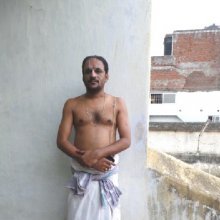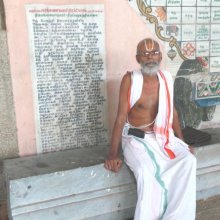Vasantotsava, Vasanta-utsava, Vasamtotsava: 13 definitions
Introduction:
Vasantotsava means something in Hinduism, Sanskrit, the history of ancient India. If you want to know the exact meaning, history, etymology or English translation of this term then check out the descriptions on this page. Add your comment or reference to a book if you want to contribute to this summary article.
Images (photo gallery)
In Hinduism
Chandas (prosody, study of Sanskrit metres)
Source: Journal of the University of Bombay Volume V: Apabhramsa metres (2)Vasantotsava (वसन्तोत्सव) is the name of a catuṣpadi metre (as popularly employed by the Apabhraṃśa bards), as discussed in books such as the Chandonuśāsana, Kavidarpaṇa, Vṛttajātisamuccaya and Svayambhūchandas.—Vasantotsava has 45 mātrās in each of its four lines, divided into the groups of 9 pañcamātras in a line.

Chandas (छन्दस्) refers to Sanskrit prosody and represents one of the six Vedangas (auxiliary disciplines belonging to the study of the Vedas). The science of prosody (chandas-shastra) focusses on the study of the poetic meters such as the commonly known twenty-six metres mentioned by Pingalas.
Shaivism (Shaiva philosophy)
Source: Open Editions: The architectural teachings of Ajitagama and RauravagamaVasantotsava (वसन्तोत्सव) or Vasantotsavavidhi [=vasantotsavavidhiḥ] is the name of chapter 65 of the Kriyāpāda of the Ajitāgama, an important Śaiva Siddhānta treatises dealing with detailed descriptions of the architecture of Śiva temples.
Source: eScholarship: The descent of scripture: a history of the KamikagamaVasantotsava (वसन्तोत्सव) refers to “spring festivals” (that are to take place in the month of Caitra), according to the Kāmikāgama: an ancient Śaiva Āgama scripture in 12,000 Sanskrit verses dating to at least the 5th century and represented as an encyclopedic account of ritual instructions (kriyāpāda).—In modern print editions, the Kāmika-āgama is structured in two major parts. The Uttarabhāga consists of 98 chapters (paṭalas) [...] Chapters 5 to 18 present a thematic focus on festivals and other occasional rites. [...] In Chapters 13 and 14, we find descriptions of spring festivals in the month of Caitra (e.g., caitramāsa-vasantotsava). Chapters 15 and 16 explain the Śītakumba festival in the month of Vaiśakha and the fruit festival in the month of Jyeṣṭha.

Shaiva (शैव, śaiva) or Shaivism (śaivism) represents a tradition of Hinduism worshiping Shiva as the supreme being. Closely related to Shaktism, Shaiva literature includes a range of scriptures, including Tantras, while the root of this tradition may be traced back to the ancient Vedas.
Pancaratra (worship of Nārāyaṇa)
Source: archive.org: Catalogue of Pancaratra Agama Texts1) Vasantotsava (वसन्तोत्सव) is the name of a festival, as discussed in the twelfth chapter of the Īśvarasaṃhitā (printed edition), a Pāñcarātra work in 8200 verses and 24 chapters dealing with topics such as routines of temple worship, major and minor festivals, temple-building and initiation.—Description of the chapter [pakṣotsava-vidhi]: [...] The remainder of the chapter is devoted to describing in more detail some of these, and other, festivals; dvādaśī is described (11-24a); madhumāsotsava (=vasantotsava) which does not appear in the above list is also described, with some options given concerning its celebration (24b-40); jalakrīḍotsava, which is part of the foregoing, and is also not mentioned in the opening ślokas, is described (41-60); ācāryabahumāna is briefly treated (61-62); and damanikotsava is covered in somewhat more detail (63-92). The following are also described: viśākhotsava (93-Iroa); plavotsava (110b-143a); āgrayaṇotsava (143b-160); ḍolotsava (161-205a); and svāpotsava (205b-234a).
2) Vasantotsava (वसन्तोत्सव) is the name of a Festival celebrated in Caitramāsa (April/May), as discussed in chapter 14 (Caryāpāda) of the Padmasaṃhitā: the most widely followed of Saṃhitā covering the entire range of concerns of Pāñcarātra doctrine and practice (i.e., the four-fold formulation of subject matter—jñāna, yoga, kriyā and caryā) consisting of roughly 9000 verses.—Description of the chapter [pavitra-ādi-utsava-vidhi]: Brahmā wants to know about the festivals that are to be observed during the various months of the year. He is told about the birthday celebrations for Rāma (3-9a) and for Narasiṃha (9b-11a), both of which come in the first month (caitramāsa—April/May); also in the same month are the flower festivals called vasantotsava and damanotsava (11-15) along with yet another flower festival, kalhārotsava (17-18). This last named festival as well as the vasantotsava-festival may alternatively come in the following month [vaiśākha—May/June]. [...]
3) Vasantotsava (वसन्तोत्सव) is the name of a festival celebrated in Caitra (i.e., the months of April-May), as discussed in chapter 27 of the Puruṣottamasaṃhitā: a Pāñcarātra text consisting of more than 1800 verses devoted to temple-building and the practical concerns of the Pāñcarātra priestly community.—Description of the chapter [saṃvatsarotsava-vidhi]: Bhagavān says that the (liturgical) year starts with the vasanta season. On the first day of this—to satisfy the deity who is guardian of that period—the vasantotsava festival is celebrated (1-3). In the first month—“caitra” [April-May]—of vasanta-season, the birth commemorations for Rāma are held (4-6a). In “caitra”-month also are to be the damanotsava-celebrations (6b-8a) and the birth commemorations of Nṛsiṃha (8b-10a). [...]
4) Vasantotsava (वसन्तोत्सव) is the name of a festival (utsava) discussed in chapter 8 of the Viṣṇutilakasaṃhitā: a Pāñcarātra text comprising 3500 Sanskrit verses covering the typically “agamic” subjects which are being narrated by Brahmā to a number of sages.—[Cf. chapter 8]: Brahmā speaks to the other sages and says he will now relate what the Lord told him about utsava-festivals. An utsava-occasion is always preceded by a flag-raising ceremony of dhvajārohaṇa. Then follows miscellaneous listing of a number of other utsavas and vratas: [e.g., vasantotsava (259-260)] [...]
5) Vasantotsava (वसन्तोत्सव) or Vasantotsavavidhi refers to the “rules for vasantotsava”, as discussed in chapter 39 of the Śrīpraśnasaṃhitā.—Description of the chapter [vasantotsava-ādi-viśākha-anta-vidhi]: Śrī asks about how and when to perform vasantotsava-celebrations. She is told that this cycle of worship should be done either in spring or in summer during the bright half of the month. No flag-hoisting is required for this, although aṅkurārpaṇa, homa, bali-offerings and rakṣābandhana, etc. are all required. In this the icon will be taken to a garden and there afforded various refreshments and entertainments, solely to please Him (1-30). [...]

Pancaratra (पाञ्चरात्र, pāñcarātra) represents a tradition of Hinduism where Narayana is revered and worshipped. Closeley related to Vaishnavism, the Pancaratra literature includes various Agamas and tantras incorporating many Vaishnava philosophies.
India history and geography
Source: Cologne Digital Sanskrit Dictionaries: Indian Epigraphical GlossaryVasanta-utsava.—(BL), spring festival. Note: vasanta-utsava is defined in the “Indian epigraphical glossary” as it can be found on ancient inscriptions commonly written in Sanskrit, Prakrit or Dravidian languages.

The history of India traces the identification of countries, villages, towns and other regions of India, as well as mythology, zoology, royal dynasties, rulers, tribes, local festivities and traditions and regional languages. Ancient India enjoyed religious freedom and encourages the path of Dharma, a concept common to Buddhism, Hinduism, and Jainism.
Languages of India and abroad
Sanskrit dictionary
Source: DDSA: The practical Sanskrit-English dictionaryVasantotsava (वसन्तोत्सव).—the vernal festival, spring-festivities, formerly held on the full-moon day of Chaitra, but now on the full-moon day of Phālguna, and identified with the Holi festival.
Derivable forms: vasantotsavaḥ (वसन्तोत्सवः).
Vasantotsava is a Sanskrit compound consisting of the terms vasanta and utsava (उत्सव).
Source: Cologne Digital Sanskrit Dictionaries: Shabda-Sagara Sanskrit-English DictionaryVasantotsava (वसन्तोत्सव).—n.
(-vaṃ) The celebration of the return of spring, formerly held on the full-moon of Chaitra, but now on the full-moon of Phalguna, being identified with the Dola-yatra or Holi. E. vasanta and utsava a festival.
Source: Cologne Digital Sanskrit Dictionaries: Cappeller Sanskrit-English DictionaryVasantotsava (वसन्तोत्सव).—[masculine] spring festival.
Source: Cologne Digital Sanskrit Dictionaries: Monier-Williams Sanskrit-English DictionaryVasantotsava (वसन्तोत्सव):—[from vasanta > vas] m. spring-rejoicings, spring festival (formerly held on the full moon of Caitra, but now of Phālguna, and = Dola-yātrā or Holī, [Indian Wisdom, by Sir M. Monier-Williams 430]), [Śakuntalā; Kathāsaritsāgara]
Source: Cologne Digital Sanskrit Dictionaries: Yates Sanskrit-English DictionaryVasantotsava (वसन्तोत्सव):—[vasanto+tsava] (vaṃ) 1. n. Vernal festival, combined with the Dola jātrā.
[Sanskrit to German]
Sanskrit, also spelled संस्कृतम् (saṃskṛtam), is an ancient language of India commonly seen as the grandmother of the Indo-European language family (even English!). Closely allied with Prakrit and Pali, Sanskrit is more exhaustive in both grammar and terms and has the most extensive collection of literature in the world, greatly surpassing its sister-languages Greek and Latin.
Kannada-English dictionary
Source: Alar: Kannada-English corpusVasaṃtōtsava (ವಸಂತೋತ್ಸವ):—[noun] a festival observed to mark the advent of spring season.
Kannada is a Dravidian language (as opposed to the Indo-European language family) mainly spoken in the southwestern region of India.
Nepali dictionary
Source: unoes: Nepali-English DictionaryVasantotsava (वसन्तोत्सव):—n. spring festival; the festival of Holi;
Nepali is the primary language of the Nepalese people counting almost 20 million native speakers. The country of Nepal is situated in the Himalaya mountain range to the north of India.
See also (Relevant definitions)
Partial matches: Vasanta, Utsava.
Starts with: Vasantotsavacarita, Vasantotsavadivishakhantavidhi, Vasantotsavavidhi.
Query error!
Full-text (+44): Vasantotsavacarita, Vasantamahotsava, Vasantotsavavidhi, Vasantaja, Vasamtotsava, Vasantotsav, Vasantasamayotsava, Madhutsava, Caitramasa, Madhumasa, Madhumasotsava, Vaishakhamasa, Cittirai, Adhyayana, Phalgunamasa, Vasantotsavadivishakhantavidhi, Mahalakshmyutsava, Mahalakshmi, Ashadhamasa, Tilapadmotsava.
Relevant text
Search found 11 books and stories containing Vasantotsava, Vasamtotsava, Vasaṃtōtsava, Vasanta-utsava, Vasantōtsava; (plurals include: Vasantotsavas, Vasamtotsavas, Vasaṃtōtsavas, utsavas, Vasantōtsavas). You can also click to the full overview containing English textual excerpts. Below are direct links for the most relevant articles:
Isanasivagurudeva Paddhati (study) (by J. P. Prajith)
13. Kamadeva in Isanasivagurudeva-paddhati < [Chapter 3 - Depiction of Gods and Goddesses]
46. Description of Vasantapuja (and Damanakotsava) < [Chapter 4 - Worship of Gods and Goddesses]
Notices of Sanskrit Manuscripts (by Rajendralala Mitra)
Page 7 < [Volume 5 (1879)]
Sanskrit sources of Kerala history (by Suma Parappattoli)
8. Srngarasudhakara by Aswathi Thirunal < [Chapter 5 - Sanskrit Dramas and Campus bearing on Kerala History]
10. Vasulaksmikalyana by Venkata Subrahmanya Dhavarin < [Chapter 5 - Sanskrit Dramas and Campus bearing on Kerala History]
4. Pradyumnabhyudaya by Ravivarma Kulasekhara < [Chapter 5 - Sanskrit Dramas and Campus bearing on Kerala History]
Devala-smriti (critical study) (by Mukund Lalji Wadekar)
6.2. Staying at one place, during rainy season < [Chapter 9 - The distinctive features of the Devalasmriti]
Literary Achievements of Tallapaka Poets < [October – December, 1978]
Nanalal The Poet-Visionary < [October 1960]
Theatre-Architecture in Ancient India < [January-February 1933]
Apastamba Dharma-sutra (by Āpastamba)

